#ajanta paintings
Text
youtube
0 notes
Text
AJANTA CAVES || RECLINING BUDDHA STATUE.
The Ajanta Caves are approximately thirty rock-cut Buddhist cave monuments dating from the second century BCE to about 480 CE in the Aurangabad district of Maharashtra state in India. The caves include paintings and rock-cut sculptures described as among the finest surviving examples of ancient Indian art.
#ajanta caves#maharashtra#travel photography#travel#tourism#videos#india#painting#archaeological site#inscription#buddha statue#buddhist#buddhism#unesco#tourist attraction
1 note
·
View note
Text

1 note
·
View note
Text
Resource Masterlist: Indian Art

Cheap/Free resources:
Wkipedia:
Wikipedia of Indian Art: I'll recommend reading the subtopics from bottom up; it seems more relevant that way!
Wikipedia of Indian Painting: once you go through this article you should further look into whichever style you like, and learn it in depth. It also has links to vernacular art.
Rasa: the classical theory of Indian aesthetics
From Archive.Org (maybe scholarly and/or illustrative. In case illustrations are not there, simply Google them for reference):
Stone Age Painting in India by Romert Brooks
The arts of India from prehistoric to modern times by Ajit Mookerji (If you have no idea about Indian arts, START HERE; it's a short book full of illustrations)
Rajput painting : romantic, divine and courtly art from India by Ahluwalia, Roda
Indian Painting by C Sivaramamurti
South Indian Paintings by C Sivaramamurti
Approach to nature in Indian art and thought by C Sivaramamurti
[There are many books on Indian art, architecture and sculpture by C Sivaramamurti on Archive.org. It's basically a goldmine.]
Kalighat : Indian popular painting, 1800-1930 by Balraj Khanna
Art of modern India by Balrak Khanna [Again, you can check out other titles by Khanna.]
Indian Textiles by John Gillow
Traditional Indian Textiles by John Gillow
South-Indian images of gods and goddesses by HK Sastri
Myths and symbols in Indian art and civilization by Heinrich Zimmer (no illustrations)
The art of Indian Asia, its mythology and transformations by Heinrich Zimmer (with illustrations)
History of Indian and Indonesian art by Ananda Coomaraswamy
A Concise History of Indian Art by Roy C Craven
Deccani Painting by Mark Zebrowski
Indian Folk Art by Heinz Mode; Subodh Chandra
Women of India by Otto Rothfeld (this isn't about art but has few informative illustrations on regional costumes of women)
Dress And Ornaments In Ancient India by Mohini Verma and Keya Bawa
Classical dances and costumes of India by Ambrose, Kay
Cultures and Costumes of India and Sri Lanka by Kilgallon, Conor (o course i had to see other books on costumes)
Studies In Indian Painting by DB Taraporevala
Five Thousand Years of Indian Art by Hermann Goetz
Indian Painiting by Philip Rawson
The Art of Tantra by Philip Rawson
MS Randhawa (different books on Punjabi paintings Basohli, Kangra, Guler and General Themes in Indian Painting)
The imperial image: paintings for the Mughal court by Beach, Milo Cleveland
Wonders of nature : Ustad Mansur at the Mughal court by Dāśa, Aśoka Kumāra
Imperial mughal painting by Welch, Stuart Cary
Painted delight : Indian paintings from Philadelphia collections
India : life, myth and art by Ram-Prasad, Chakravarthi
The heritage of Indian art by Agrawala, Vasudeva Sharana
The adventures of Rama : with illustrations from a sixteenth-century Mughal manuscript
Indian paintings from the Punjab Hills by WG Archer
Art in East and West by Rowland Benjamin
Stella Kramisch (An American art historian and curator who was a leading specialist on Indian art, including folk art, for most of the 20th century. Also a Padma Bhushan awardee.)
The transformation of nature in art by Coomaraswamy, Ananda K
Books available on Libgen:
Art Of Ancient India : Buddhist, Hindu, Jain by Huntington and Huntington
The New Cambridge History of India, Volume 1, Part 3: Mughal and Rajput Painting
Myths and Symbols in Indian Art and Civilization by Heinrich Zimmer
Four Centuries of Rajput Painting: Mewar, Marwar and Dhundhar Indian Miniatures from the Collection of Isabelle and Vicky Ducrot
Ajanta by Yazdani
The Aesthetic Experience Acording to Abhinavagupta
TheHeritageLab is a free website to connect you to cultural heritage through stories, public engagement programs, campaigns, and free-access content.
Also if you're in Delhi, do consider getting a membership of Indira Gandhi National Centre for the Arts (IGNCA) library.
Folk art:
Folk art is an entirely different area that deserve a post of its own. But i love them so here is a long list by Memeraki.com. You can Google each and then look more into what you like. This website also offers very cheap courses in traditional Indian arts by the hidden and disenfranchised masters themselves! It's doing a great work in giving them a platorm. I myself have taken the Mughal Miniature course here. You can consider it.
Illustrated Books:
Note: These are coffee table books with beautiful illustrations that you'd love to looks at.
The Night Life of Trees: In the belief of the Gond tribe, the lives of humans and trees are closely entwined. A visual ode to trees rendered by tribal artists from India, this handcrafted edition showcases three of the finest living Gond masters. THIS YOUTUBE LINK shows the making of the book. The channel also features other works of Gond art.
An Unknown Treasure in Rajasthan: The Bundi Wall-Paintings: This book celebrates the surviving wall-paintings at Bundi by presenting a stunning photographic survey
Painting In the Kangra Valley: Painting in the Kangra Valley is an attempt to survey the painting styles of Guler and Kangra, which flourished in the 18th and 19th centuries. The painting activity began with Kashmiri painters (...)
Indian Painting: The Lesser Known Traditions: India has an astonishingly rich variety of painting traditions. While miniature painting schools became virtually extinct with the decline of aristocratic patronage, a number of local vernacular idioms still survive and continue to develop.
Madhubani Art: Indian Art Series: Madhubani art's origin is believed to go back to the ancient era of the Ramayana, when the town was decorated by inhabitants of the region for the wedding of Lord Rama and Sita with elaborate wall paintings and murals (...) Primarily a significant socio-cultural engagement for the womenfolk of Bihar, this art was a welcome break from their daily drudgery.
Reflections on Mughal Art and Culture: Enter the splendid world of Mughal India and explore its rich aesthetic and cultural legacy through fresh insights offered by 13 eminent scholars.
Monsoon Feelings: A History of Emotions in the Rain: Through a series of evocative essays exploring rain-drenched worlds of poetry, songs, paintings, architecture, films, gardens, festivals, music and medicine, this lavishly illustrated collection examines the history of monsoon feelings in South Asia from the twelfth century to the present
Sita's Ramayana shifts the point of view of the Ramayana - the saga of a heroic war - to bring a woman's perspective to this timeless epic. Illustrated with Patua painting.
Adi Parva: Churning of the Ocean: a graphic novel that is a revisionist retelling of some of our oldest tales which have inspired and guided generations of people.
Ajit Mookerji, Sivaramamurti and Craven Roy's books are concise from where one can begin and then delve deeper into the subject of interest. Reading history and myths behind the work for context and listening to music from the given time/region alongside will make the exploration even more enjoyable!
#indian aesthetics#indian art#master post of indian art#desi#desi culture#desi aesthetic#indian dark academia#indian art history#indian art history books#indian art books
26 notes
·
View notes
Note
History ask game: 4, 5, and 10
Thank you so much for your ask!
4. Favourite historical era?
Well, it depends.
To study: It's definitely the Mughal empire, and recently the Delhi Sultanate. I love learning the story of "minor characters" of the historical narratives like Rukn al-Din Firuz, Mirza Kamran, Sultan Parwez, Faizi etc. I love reading primary sources, Juzjani's Tabaqat i-Nasiri for Delhi Sultanate, Ain i Akbari and Muntakhabu-t Tawarikh for Mughal and making memes on them.
To live: Neanderthal period. Just the right amount of peace, culture and community feeling.
5. Favourite weapon?
Okay, I'll be honest, I know very less about military technology. But those Mughal daggers seem very aesthetic to me. Although, I think, pen is the greatest weapon out there, because diplomacy > military
10. Pieces of art ( paintings, sculpures, lithographies, ect.) related to history you like most ( post an image of them)
I actually love the medieval era (a broad time period) so I'll put a painting and one sculpture. The painting is a Mughal portrait of Sultan Parwez Mirza, second son of Jahangir. I love the colour composition and the soft expression that perfectly suits the filial son he was. The sculpture is of Varuna as a dikpala of Rajarani temple, Odisha. It looks even better in front of eyes. Honorable mention, Ajanta-Ellora. I visited there last year and it is stunning! (Indian architecture is really amazing)

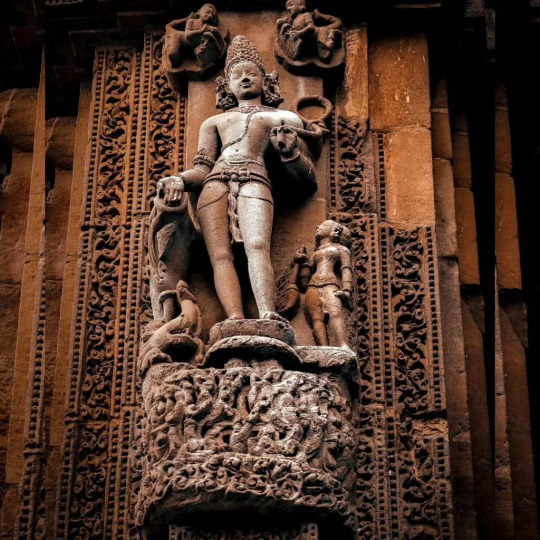
Thanks again for your ask!
2 notes
·
View notes
Text
A friend came to visit Picasso when he was making a pictue.
He was so lost in his work that the friend thought it best not to disturb him. When the painting was put up for sale the friend bought it, it was worth millions of rupees. One day he took the painting along with him when he visited Picasso and asked him to authenticate it.
Many fake copies were sold in the market as Picasso's own works, but this one the friend had seen him paint with his own eyes. Picasso replied, "I have made it all right, but it is not genuine." The friend was puzzled, for an authentic painting according to him was one that the painter paints himself. "It is authentic," explained Picasso, "in the sense that I have made it, but it is inauthentic insofar as it is only a reflection of my earlier paintings. I was copying my own style. The creator in me was not present at the time."
"What do you mean by the creator in you?" asked the friend.
"I am the creator when I make a unique painting, when I am totally original."
Therefore poets, painters, sculptors are closest to God when they produce something really original; they are as near God as a saint of devotee. A sculptor carving the images at the caves at Ajanta or Elona was as close to God when he created these as even Buddha was.
Whenever you create something that is not a copy, not an imitation, there is no prayer that is greater.
Osho
6 notes
·
View notes
Text
culture of India
India, often referred to as the land of diversity, is a cultural kaleidoscope that has fascinated and enchanted people from across the globe for centuries. Its rich heritage, traditions, languages, art forms, and cuisines reflect a civilization that has evolved over millennia, leaving an indelible mark on the world. In this blog, we embark on a journey to unravel the multifaceted culture ,culture of India delving into its historical roots, religious practices, artistic expressions, and modern-day manifestations.

Historical Background:
The cultural history of India can be traced back to ancient times, with evidence of human habitation dating back to the Stone Age. The subcontinent has witnessed the rise and fall of numerous civilizations, including the Indus Valley Civilization, which flourished around 3300 BCE. Subsequent waves of migration and settlement by various ethnic groups, including Aryans, Dravidians, Greeks, Persians, and Mongols, contributed to the diversity of India's cultural landscape.
Religious Diversity:
India is the birthplace of major religions such as Hinduism, Buddhism, Jainism, and Sikhism, and has also been a melting pot of diverse faiths, including Islam, Christianity, Judaism, and Zoroastrianism. The religious tolerance and syncretism prevalent in India have resulted in a vibrant tapestry of rituals, festivals, and spiritual practices that coexist harmoniously. From the grand celebrations of Diwali and Eid to the solemnity of Buddhist retreats and Sikh gurdwaras, religion permeates every aspect of Indian life, shaping its customs, beliefs, and social structures.
Art and Architecture:
Indian art and architecture are renowned for their intricacy, symbolism, and spiritual significance. The ancient rock-cut temples of Ajanta and Ellora, the majestic forts and palaces of Rajasthan, and the exquisite carvings of temples in Khajuraho are testaments to India's rich architectural heritage. The country's artistic traditions encompass a wide array of mediums, including painting, sculpture, pottery, textiles, and performing arts such as dance, music, and theater. Classical dance forms like Bharatanatyam, Kathak, Odissi, and Kuchipudi, with their roots in mythology and spirituality, continue to captivate audiences worldwide with their grace and elegance.
Cuisien:
Indian cuisine is as diverse as its culture, with each region boasting its own unique flavors, ingredients, and cooking techniques. From the fiery curries of the south to the aromatic biryanis of the north, Indian food is a gastronomic delight that tantalizes the taste buds with its rich spices and bold flavors. Staples like rice, wheat, lentils, and vegetables form the foundation of Indian meals, which are often accompanied by chutneys, pickles, and dairy products like yogurt and paneer. Street food is also a ubiquitous part of Indian culinary
culture, offering a tantalizing array of snacks and sweets that cater to every palate.
Literature and Language:
India has a rich literary tradition dating back thousands of years, with ancient texts like the Vedas, Upanishads, and epics like the Ramayana and Mahabharata shaping the cultural consciousness of the nation. Sanskrit, the classical language of ancient India, has been the vehicle for some of the world's most profound philosophical and literary works. Over the centuries, regional languages like Tamil, Telugu, Kannada, Bengali, Marathi, Gujarati, and Punjabi have flourished, producing a wealth of literature in poetry, prose, and drama. The Indian diaspora has also made significant contributions to world literature, with writers like Salman Rushdie, Arundhati Roy, and Jhumpa Lahiri garnering international acclaim for their works.
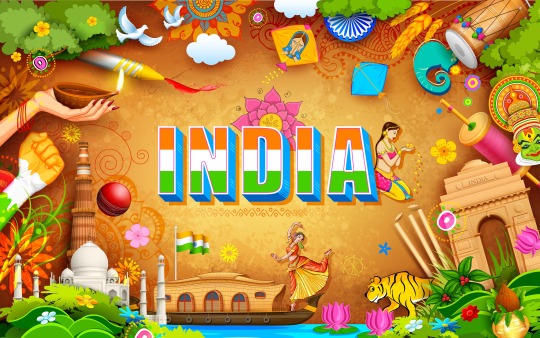
Modern Cultural Expressions:
While India's cultural heritage is deeply rooted in tradition and history, it is also a dynamic and evolving entity that continues to adapt and innovate in response to changing times. The advent of globalization, urbanization, and technology has ushered in new forms of cultural expression, from Bollywood films and indie music to contemporary art and fashion. Social media platforms like Instagram and YouTube have provided a platform for young Indian artists, musicians, and influencers to showcase their talents and connect with audiences around the world. Despite the challenges of modernization, India remains proud of its cultural heritage, embracing both tradition and innovation in equal measure.
Conclusion: India's cultural tapestry is a testament to the resilience, creativity, and diversity of its people. Across the length and breadth of the subcontinent, from the snow-capped Himalayas to the sun-drenched beaches of Kerala, the spirit of India's cultural heritage continues to thrive, enriching the lives of millions and inspiring generations to come. As we celebrate the vibrant mosaic of traditions, languages, and customs that make up the fabric of Indian society, let us also recognize the importance of preserving and safeguarding this invaluable legacy for future generations to cherish and embrace.
2 notes
·
View notes
Text

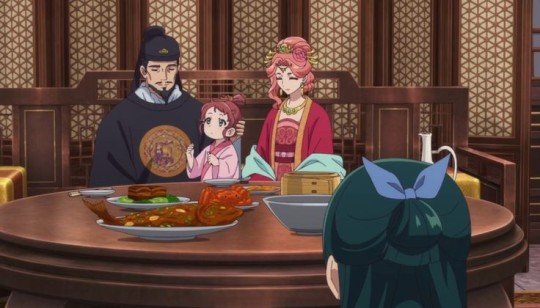
Lingli actually means White Jasmine in Chinese.
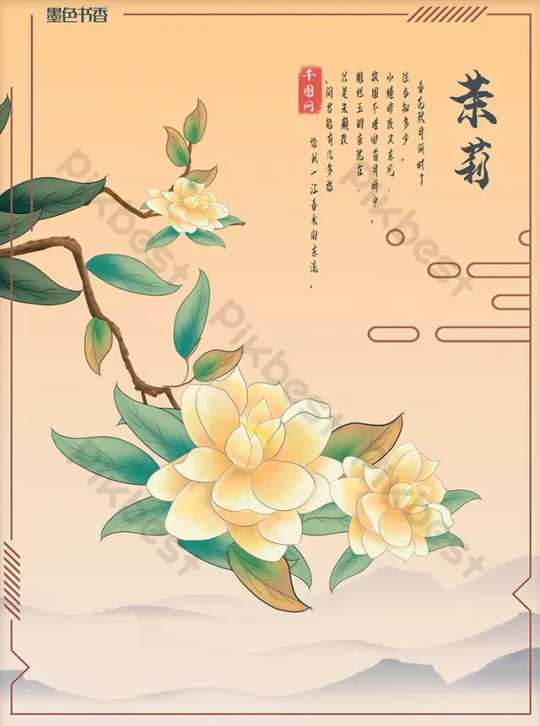
Jasmine has symbolic meanings in the Chinese culture. This flower is not only the symbol of forever love but also one of the holy flowers of Buddhism. For example, the crown of the Buddhist in the Ajanta wall paintings, a world heritage site, is decorated by golden jasmine flowers. The fragrance of jasmines is thought to be of heaven.
It also means clever, quick-witted and bright.
https://www.uniguide.com/jasmine-flower-meaning
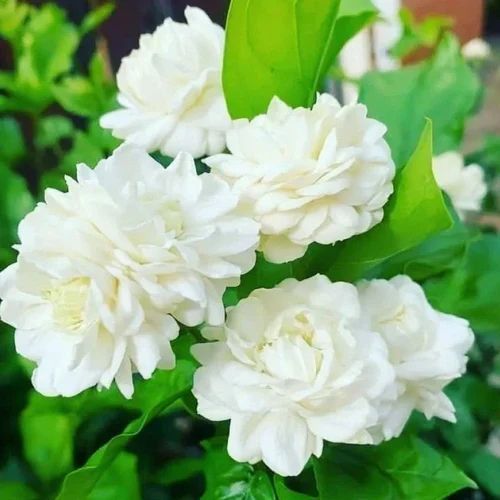
4 notes
·
View notes
Text
7 UNESCO Heritage Sites of India by Bright Holidays
Introduction:
India is a country with a lot of different cultures, a long and interesting history, and beautiful natural scenery. It has many places that tourists from all over the world find interesting. Whether it’s amazing buildings or places of worship, India’s tourist spots provide a wide range of experiences. Here, Bright Holidays presents a curated list of seven UNESCO World Heritage sites that encapsulate India’s unique charm.
UNESCO World Heritage Sites of India:
1. Taj Mahal:
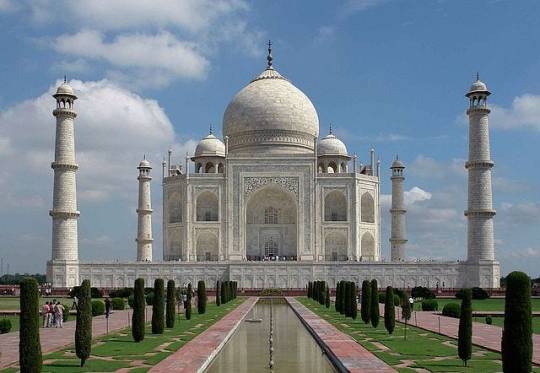
Undoubtedly one of the most iconic symbols of India, the Taj Mahal stands as a testament to eternal love. Located in Agra, Uttar Pradesh, this pristine white marble mausoleum was commissioned by the Mughal Emperor Shah Jahan in memory of his beloved wife, Mumtaz Mahal. Its intricate architecture, intricate carvings, and the mesmerizing play of light during sunrise and sunset make the Taj Mahal a must-visit destination for any traveller.
2. Red Fort:

Situated in the heart of Delhi, the Red Fort, or Lal Qila, is a historic fortress that served as the main residence for Mughal emperors for nearly 200 years. Constructed using red sandstone, the fort is a remarkable blend of Persian, Timurid, and Indian architectural styles. The Red Fort hosts the annual Independence Day celebrations of India on August 15th.
3. Champaner-Pavagadh Archaeological Park:

Located in Gujarat, this UNESCO World Heritage site encompasses the archaeological remnants of a medieval capital and the hill fortress of Pavagadh. Recognized in 2004, it showcases a harmonious blend of Hindu-Muslim architecture and culture. Highlights include the Jami Masjid and intricately carved temples on Pavagadh Hill, offering a glimpse into the historical and cultural significance of this unique site.
4. Qutab Minar:

Delhi, with its rich history, is home to the Qutab Minar, the tallest brick minaret in the world. Built-in the 12th century, the Qutab Minar complex includes various historical structures and ruins, such as the Iron Pillar of Delhi. The intricate carvings on the minaret narrate the history of its construction and the dynasties that ruled over Delhi.
5. Konark Sun Temple:

Located in the state of Odisha, the Konark Sun Temple is a mesmerizing architectural marvel dedicated to the sun god Surya. Built in the 13th century, the temple is renowned for its intricate stone carvings that depict scenes from daily life, mythology, and the celestial world. The temple’s chariot-shaped design and the precision of its artwork make it a UNESCO World Heritage Site.
6. Ajanta Caves:

The Ajanta Caves, located in India, are a fascinating historical site with a lot to offer. These caves are known for their ancient rock-cut architecture and beautiful paintings that depict scenes from the life of Buddha. Visiting the Ajanta Caves provides a unique and captivating experience, allowing you to explore the rich cultural and artistic heritage of India.
7. Ellora Caves:

In the western state of Maharashtra, the Ellora Caves comprise a series of rock-cut temples representing Hindu, Buddhist, and Jain traditions. Carved between the 6th and 10th centuries, the caves showcase the artistic and architectural prowess of ancient India. The Kailasa Temple, dedicated to Lord Shiva, is a highlight, featuring a monolithic structure carved from a single piece of rock.
Conclusion:
Embark on a journey through these seven iconic UNESCO World Heritage Sites, each narrating a unique story of India’s history, cultural diversity, and architectural brilliance. As you explore the Taj Mahal, Red Fort, Golden Temple, Qutab Minar, Konark Sun Temple, Ajanta Caves, and Ellora Caves, witness the timeless beauty that invites you to discover the magic within India’s borders. Bright Holidays invites you to embrace the richness of India’s past and present, offering a profound and unforgettable travel experience amidst these UNESCO treasures.
About Us:
Bright Holidays proudly holds the title of the best tour and travel agency in Ahmedabad, offering unparalleled travel experiences that cater to your every wanderlust desire. Whether you’re dreaming of international adventures, exploring captivating domestic destinations, or seeking personalized travel itineraries, our dedicated team is committed to creating seamless, remarkable journeys that transform your dreams into unforgettable memories.
3 notes
·
View notes
Photo

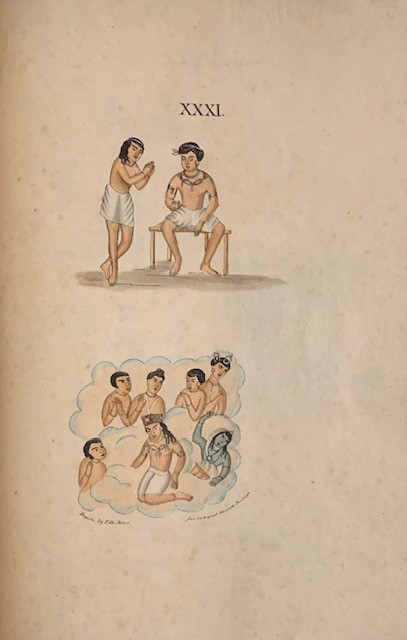
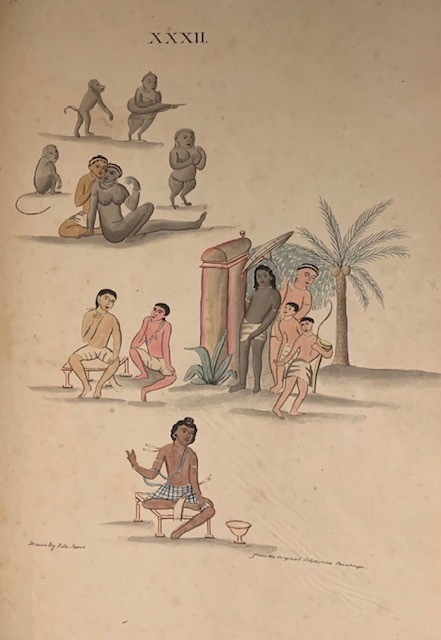
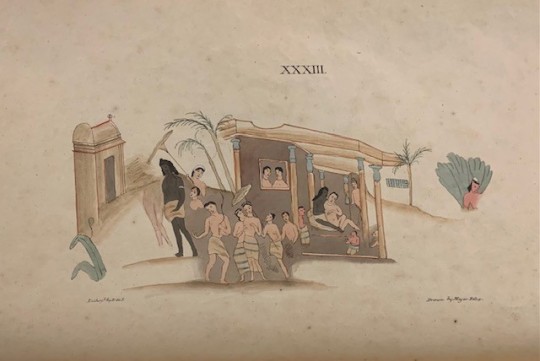
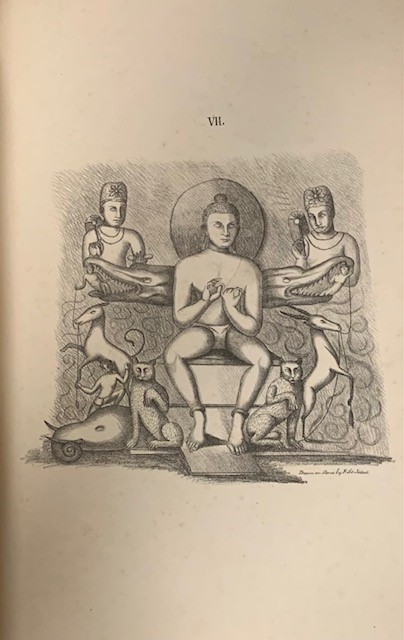
Preservation and Destruction
These images are from an early Western attempt to approach the historical origins of Buddhism and Jainism. Included in the many colored plates in this book are depictions of paintings in the caves of Ajanta in India. Though he may be credited in preserving the images through reproductions like these, the book’s author, James Bird (a medical missionary to India) is also reported to have peeled off and removed one or more paintings on a visit 20 years prior, destroying them in the process.
Bird, James. Historical researches on the origin and principles of the Bauddha and Jaina religions : embracing the leading tenets of their system, as found prevailing in various countries; illustrated by descriptive accounts of the sculptures in the caves of western India, with translations of the inscriptions of Kanari, Karli, Ajanta, Ellora, Nasik, &c. which indicate their connexion with the coins and topes of the Panjab and Afghanistan. Bombay: Printed at the American Mission Press, 1847.
27 notes
·
View notes
Text

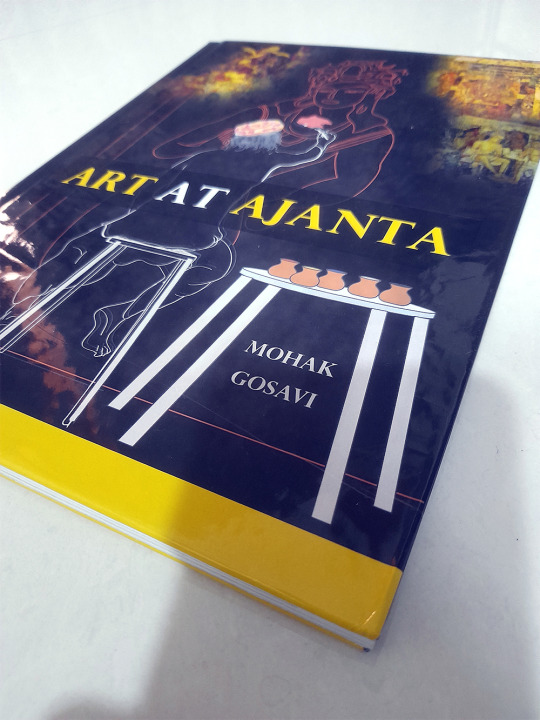
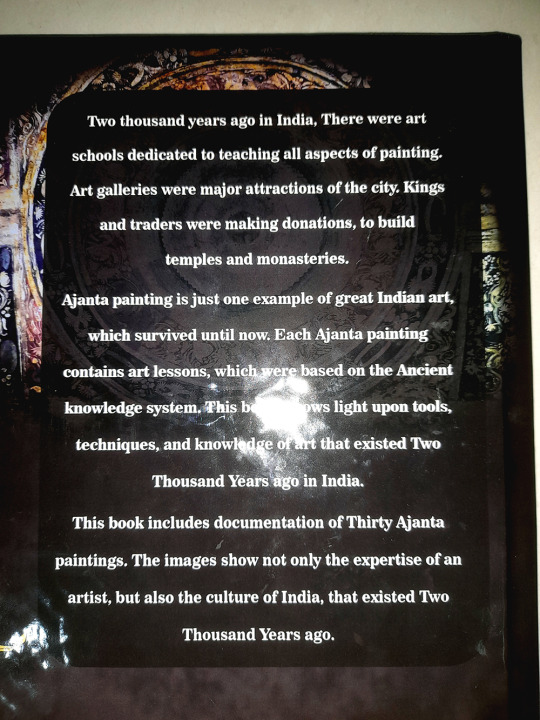



To order online ( Free home delivery + 10% early bird discount), please click here
This book answers the various questions such as ‘What makes ‘Art at Ajanta’ best in the world’, ‘ What materials were used in ancient times in India’, ‘What are Ajanta paintings all about?’, ‘What is so unique about Indian art’, ‘How to create painting using ancient method, mentioned in Sanskrit textbooks’. By Reading this book, a Student will also learn the uniqueness of Indian art.
Topics covered in this book –
Research-based information about Indian art and Ajanta paintings
Photos of Ajanta paintings, which are restored digitally
Large size photos of Ajanta paintings
How to study Ajanta paintings
What are ancient design principles mentioned in Sanskrit textbooks of India.
How to create painting using Indian method
Learn about painting materials, which were used for Ajanta paintings
Photos of Sculptures at Ajanta
This book will make every Indian artist feel proud about his culture and heritage.
#Acrylics#paintings#colors#art#india#ajanta#indianart#ajintha#murals#wall paintings#jatakatales#buddhist#ajantapainting
0 notes
Note
Would you be able to do a summary or do you have resources for periods/schools of Indian art?
Hi there I think Partha Mitter's books cover a lot of art schools in colonial India (Bengal, Bombay, Company paintings etc). I also found a youtube link.
I used to use Benoy Behl's book for Ajanta paintings, I see he has a youtube channel.
I think the Met had made available some of Stuart Cary Welch's books on Indian miniature paintings.
There is obviously a lot more but I think for the lay reader these give a fairly good overview. To be honest, I only look at the material from a costume perspective rather than art.
28 notes
·
View notes
Text

•24.08.23• p- 44/100•
Yes. I was down with a fever yesterday and couldn’t study at all. I have my maths exam today. I swear if I had studied it would’ve been so nice since I knew ALL the questions but none of the answers. Lmao. I couldn’t complete the exam. Submitted my answer script and came back home after like an hour since my temperature was rising alarmingly. This evening too was a bad health evening. It was 102 degrees and my parents seriously considered admitting me to a hospital. Thank god I got better an hour ago. Now studying for the art exam tomorrow
Things I am going to do tonight-
Study the art of Ajanta Caves chapter
Review the features of Padmapani Bodhisatva and Vajrapani Bodhisatva. Read about Mara Vijaya.
Read the chapter art of the Indus Valley Civilisation with highlights on the Male torso and Dancing girl statue
Read the chapter ancient world cave art.
Study the “introduction to Painting”
Read the chapter art of the Sunga, Kushana, and Gupta Dynasty
I literally never touched my painting book. It’s the first time I am reading it and tomorrow is exam. Lol. It’s a painting overdose today.
#academia#stem academia#studyblr#academia aesthetic#classic academia#dark academia#student life#chaotic academia#grey academia#light academia#studying#study blog#study motivation#studygram#studyinspo#study aesthetic#studystudystudy#study hard#studyspo#studyspiration
3 notes
·
View notes
Text
Day 7
July 15th, 2023
Hello from Aurangabad! My name is Scott, and I’m excited to give you all a glimpse into what has been (in my opinion) one of the best days of our trip so far! After hearing so many good things about the Ajanta Caves (a World Heritage Site) and the village visit we’d be going on today, we were all excited to hop onto the bus to go, even if it was at 7:30 AM! On our way to our first stop, the Ajanta Caves, we got to meet with and hear a bit from our amazing guide, Amod. For the rest of the 2+ hour drive, some of us took the opportunity to catch up on some sleep, while others worked on some assignments and took in the scenery!


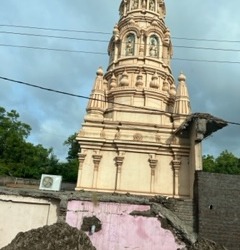
After a bumpy (but fun) ride, we were given a celebrity’s welcome to the Ajanta Caves! Dozens of shopkeepers spotted us from our bus and gathered around, trying to sell us trinkets like Buddha statues and magnets. After our time in the limelight, we were all ready to explore our first stop!
The Ajanta Caves were like nothing I’d ever seen before. As our guide explained, the dozens of caves were actually monoliths carved out of the hills around the site many centuries ago. We all enjoyed learning more about Buddhism and seeing the intricate carvings and paintings throughout the site.
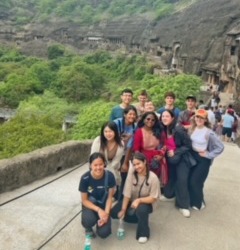


Once our guide had finished walking us through many of the caves and explaining their contexts, meanings, and significance, we set off for some free-time adventures around the site. Some of us took the opportunity to try some fresh pineapple treats, while others (including me) speed-hiked to the top of a hill we saw nearby, where we were able to see a pagoda and waterfall! Even though it started pouring on us as soon as we got to the top, we all still had a great time.
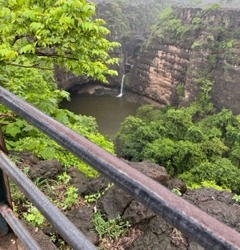
After grabbing a quick lunch, we headed off toward the village of Paal! A little while (and one impromptu roadside goat-adjacent bathroom break) later, we arrived at our destination! This visit may have been one of the craziest experiences of my entire life. When we arrived at the village temple, there were only a few people around who began speaking with our group, but after a while, dozens of adults and children gathered around to see the new arrivals. We had the opportunity to hear from village leaders about aspects of local life such as governance and religion, enter the local temple, hear some children practice their English, watch monkeys jump around (and throw coconuts at some of us), and be photographed by and with locals so many times. A journalist even showed up and began recording us on his phone! Walking (or in some cases motorcycling) back to our bus, we interacted with the local residents even more and cherished the opportunity to see life from their perspectives for a short period of time. Needless to say, we all enjoyed the experience and were a bit sad to be leaving so soon.


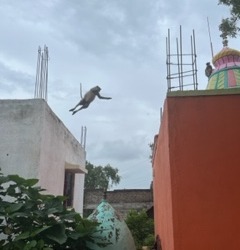
Later in the evening, we arrived back at the Lemon Tree and went our separate ways. Some of us grabbed dinner at the hotel restaurant, while others ordered food, napped, and continued our classwork. We are all a bit tired, but are very happy to have had such a nice day and excited to see what’s in store for our last day in Aurangabad tomorrow!
Good night from India!
- Scott Rappaport
5 notes
·
View notes
Text

Bandhani Sarees The India's Most Popular Authentic Clothes Category
The name "Bandhani," often spelt "Bandhej," refers to a technique mostly practised in Gujarat and Rajasthan. It is derived from the Sanskrit word "bandha," which means "to bind." It is presently highly fashionable in the mainstream. The Khatri people in Gujarat, India's rural areas, used this tie-and-dye technique first in the sixth century. According to historians, Banabhatt's Harshacharita wore the first Bandhani saree at a royal wedding. A traditional form of art is bandhani. Archives from the Indus Valley Civilization are the first to mention this method of fingernail-plucking the fabric and knotting it before dying.
Bandhani's testimony can be seen in Buddhist paintings at the famed Ajanta caves.

#bandhani#history#archaeology#clothing#indian history#sarees#indian fashion#rajasthan#gujrat#ethnic#authentic#beautiful women
6 notes
·
View notes
Text
New Delhi to Patna Flights Ticket
Flights from Delhi to Patna with Bhartiya Airways start at Rs 2199, with up to Rs 999 in cash back.
Are you interested in seeing Patna? If you use the car, it will take you around 19 to 22 hours to get there. Moreover, the distance from Delhi to Patna through road is around 1085 kilometres. Therefore, it would be wise to choose to book a flight from Delhi to Patna, as doing so will ensure that your time is not wasted and that your travel goes well. Bhartiya Airways is the only place to go if you want to get good deals on domestic flights inside India.
In addition, Bhartiya Airways makes it easy to find out since the company is always receiving ticket orders and keeping its customers up to date on pricing. Plus, Bhartiya Airways offers a wide range of flight options, so passengers may choose the trip that best suits their travel needs and preferences. We want to make sure that visitors to Patna have no trouble reserving flights, as well as locating hotels, resorts, and other forms of lodging for the duration of their trip.
The City of Patna
Patna is a city rich in history and heritage. Even though several different civilizations governed it over the course of many centuries, its rich history extends baack thousands of years. These entwined histories continue to shape contemporary Patna. Patna, the capital of Bihar, is located northeast of the Indian capital of New Delhi. The city's namesake river, the Ganges, runs straight through the centre of India's most populous state.
Patna, India, which has been there since the 5th century BC when it was first mentioned in writing and has been preserving India's affluent past, is a great example of this. For its association with the Mauryan dynasty's first king, Chandragupta Maurya, Patiliputra is a common name for the city. You may spend hours wandering around the city's historic landmarks, but the contemporary urban landscape is just as captivating. Patna's monasteries, temples, and museums continue to attract tourists long after they were first built.
You can go from Patna to Delhi by rail or aircraft, although the latter is preferable. Bhartiya Airways can help you discover the most affordable trip from Delhi to Patna, even if Indian Airlines flies there often.
Patna Airport Information
Patna is served by Jay Prakash Narayan International Airport, often known as Patna Airport. You can acquire flights and check your status with Bhartiya Airways before you purchase your tickets. Seeing whether there are any flights from Delhi to Patna is something you should check with airlines about often. Many travellers believe that the optimum time to book a ticket is just after the annual fare sale, which occurs twice a year on average.
Popular Patna Attractions with Visitors
Patna, with its illustrious past and luxurious present, is an irresistible destination. We've compiled a list of some of our favourite attractions in the city so that you may spend time seeing the sights while learning about its rich history.
• Jalan Museum
• Golghar
• Takht Sri Patna Sahib Gurgdwara
• Srikrishna Science Centre
• Nalanda Mahavihara
• Patna museum
• Khuda Bakhsh Oriental Public Library
• Mahavir Mandir
• Ruins of Pataliputra
• Gandhi Ghat
• Patna Planetarium
• Mahatma Gandhi Setu
• Ajanta
• River Ganga
• Sanjay Gandhi Botanical Garden
• Sitamarhi
• Sonepur Mela
• ISKCON Temple in Patna
• Agam Kuan
• Madhubani paintings
• Patna Eco Park
• Kumhrar Park
• Gandhi Maidan
• Shahid Smarak
What is Total Airways Distance Between Delhi to Patna
It takes 1 hour and 30 minutes to fly from Delhi to Patna, despite the fact that the distance between the two cities is just 853 kilometres. Between Delhi to Patna, there are several flights and airlines. With a month's notice, we won't have to wait in line for an airport shuttle or stress out about getting a visa in time. Therefore, the best deals may be found if you book at least a month in advance.
Essential Travel Documents Required for Boarding Flights
Be cautious with any forms of identification that you bring on your vacation.
The Passport
Identification for Voters
Cards with the Aadhar Identifier System
To be able to drive legally, you need:
• Proof of Immunization ( digital or paper form)
• Student or children's identification cards for schools and universities
Thanks to technological advancements and the availability of faster modes of transportation, you may now get a digital copy of your Air ticket from Delhi to Patna and have it printed off. With this, you may prove to the authorities that you have finalised your trip arrangements and that no one has any idea when you could be leaving.
Explaining Why Bhartiya Airways Is a Reliable Choice for Flights from Delhi to Patna
It might be difficult to choose the best airline booking aggregator among the many available. Please allow us to demonstrate why we are superior to the others.
Those who have a penchant for spontaneous travel will discover that our website is a treasure trove of options for booking flights to their chosen location. Choose your price, travel class, and airline according to your needs, preferences, and budget.
You can count on us to help you book low-cost flights from Delhi to Patna, and our dedicated relationship manager will be there to answer any questions you may have along the way. We are sensitive to our customers' requirements, and we advise them on the best time to travel while also ensuring that they have a safe and enjoyable trip.
Bhartiya Airways offers low-cost domestic flights throughout India. Flight prices vary, but they do their best to provide low-cost options. You, too, may travel worry-free around the globe. Bhartiya Airways will never force you to check your flight's status, but they will give you updates when necessary so you can stay on top of things and get things done.
In addition, there is no red tape involved in getting a refund or cancelling a ticket with Bhartiya Airways. Your flight reservation may be cancelled up to 2 hours before departure. In addition, our team is helpful when filing a refund claim and can often get your money refunded to you in 3-4 business days.
No need to worry if you have no idea how to book flights from Delhi to Patna; our devoted technicians and support desk are available to assist you in booking flights to any destination in India or overseas.
Learn How to Get Cheap Flights on Bhartiya Airways from Delhi to Patna.
Visit the Bhartiya Airways website and sign in using your proper email address, password, and username. We've picked the ideal time to travel and there are plenty of terrific options for airlines. From Delhi to Patna, you can book a round-trip flight to any major city in the globe for about Rs200.
Bhartiya Airways offers the most affordable domestic and international flight booking options. You should enter your departure date first, followed by your return date. To proceed, please use the drop-down menus below to pick the flight's cabin and the number of passengers. Finding the best flight may be a time-consuming ordeal, but our automatic search will do the hard work for you.
6 notes
·
View notes